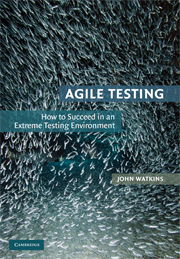Book contents
- Frontmatter
- Contents
- Foreword by Bob Bartlett
- Acknowledgments
- 1 Introduction
- PART 1 REVIEW OF OLD-SCHOOL AND AGILE APPROACHES
- PART 2 EVERYONE IS DIFFERENT: AGILE CASE STUDIES
- PART 3 AGILE MY WAY: A PROPOSAL FOR YOUR OWN AGILE TEST PROCESS
- APPENDIX A The Principles of Rapid Application Development
- APPENDIX B The Rules and Practices of Extreme Programming
- Appendix C The Principles of the Dynamic Systems Development Method
- Appendix D The Practices of Scrum
- APPENDIX E Agile Test Script Template
- Appendix F Agile Test Result Record Form Template
- Appendix G Agile Test Summary Report Template
- Appendix H My Agile Process Checklist
- References
- Index
APPENDIX E - Agile Test Script Template
Published online by Cambridge University Press: 26 October 2009
- Frontmatter
- Contents
- Foreword by Bob Bartlett
- Acknowledgments
- 1 Introduction
- PART 1 REVIEW OF OLD-SCHOOL AND AGILE APPROACHES
- PART 2 EVERYONE IS DIFFERENT: AGILE CASE STUDIES
- PART 3 AGILE MY WAY: A PROPOSAL FOR YOUR OWN AGILE TEST PROCESS
- APPENDIX A The Principles of Rapid Application Development
- APPENDIX B The Rules and Practices of Extreme Programming
- Appendix C The Principles of the Dynamic Systems Development Method
- Appendix D The Practices of Scrum
- APPENDIX E Agile Test Script Template
- Appendix F Agile Test Result Record Form Template
- Appendix G Agile Test Summary Report Template
- Appendix H My Agile Process Checklist
- References
- Index
Summary
Introduction
The following pages of this appendix contain a test script template (Figure E.1) that may be copied and used within your own testing task or project.
The test script template contains the following sections:
Project ID – the unique project identifier;
AUT Name – the definitive name of the Application Under Test (front sheet only);
AUT Version – the definitive version information for the Application Under Test (front sheet only);
Iteration ID – the unique identifier for the iteration this test is being conducted in (front sheet only);
Date of Test – the planned start date of testing (front sheet only);
Test ID – the unique identifier for the test;
Purpose of Test – a brief description of the purpose of the test including a reference, where appropriate, to the requirement that is to be tested (consider providing references to the requirements specification, design specification, user guide, operations guide, and/or installation guide), as well as any dependencies from or to other test scripts/test cases;
Test Environment – a brief description of the environment under which the test is to be conducted (may include a description of the state of the AUT at the start of this test, details regarding the platform or operating system, as well as specific information about data used in this test);
Test Steps – concise, accurate, and unambiguous instructions describing the precise steps the tester must take to execute the test, including navigation through the AUT as well as any inputs and outputs; and
Expected Result – a brief and unambiguous description of the expected result of executing the test.
- Type
- Chapter
- Information
- Agile TestingHow to Succeed in an Extreme Testing Environment, pp. 284 - 291Publisher: Cambridge University PressPrint publication year: 2009



